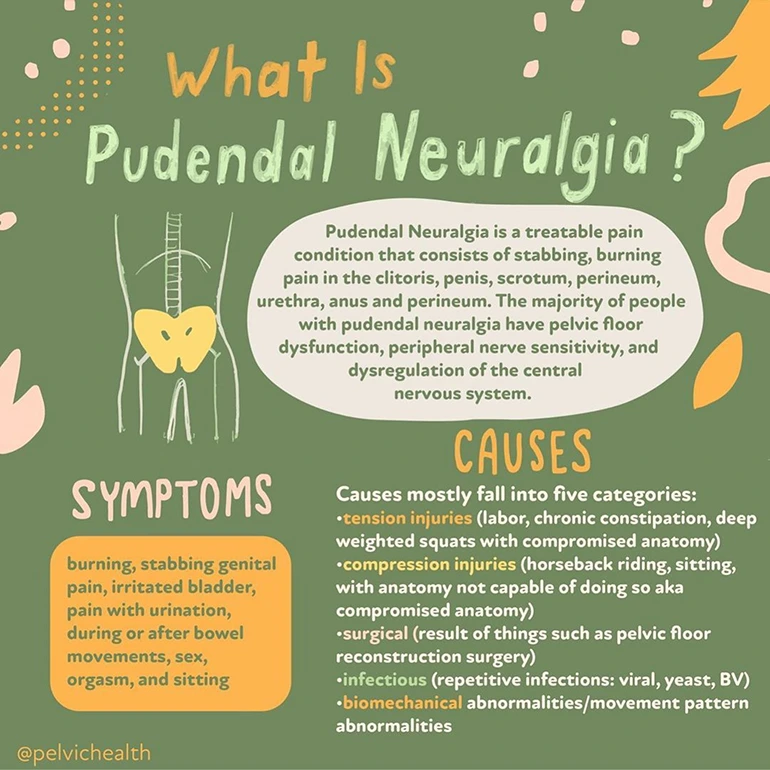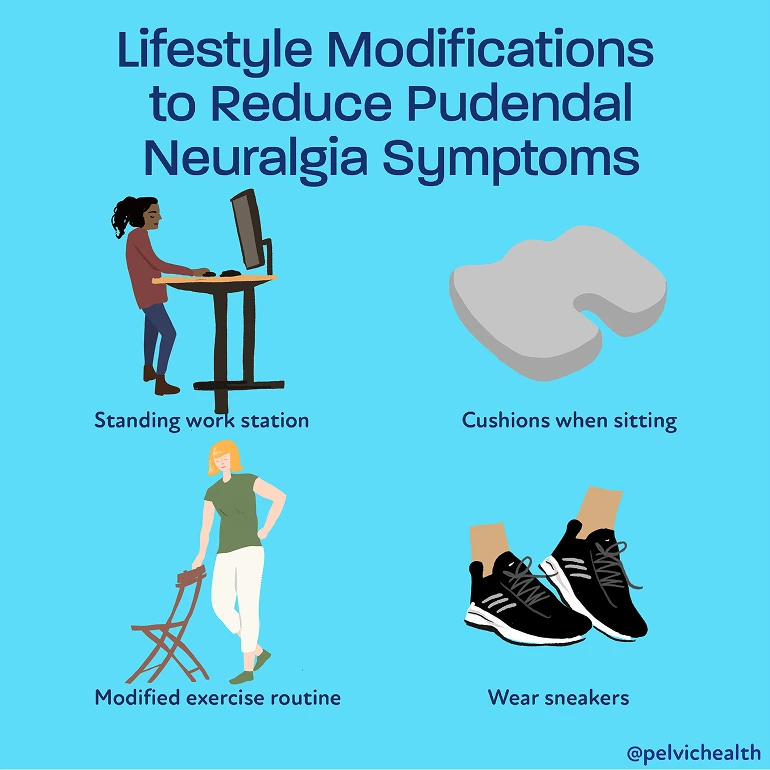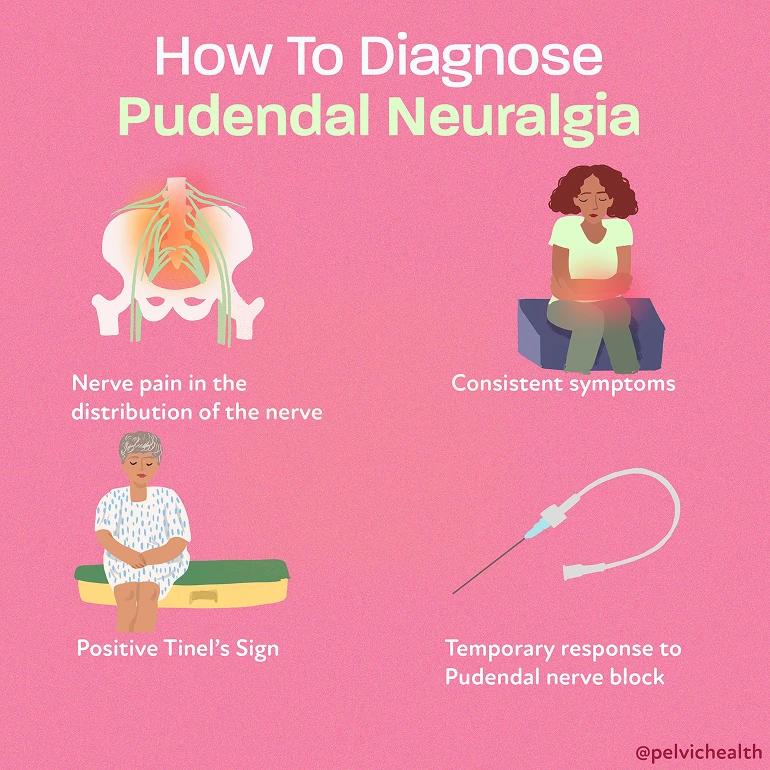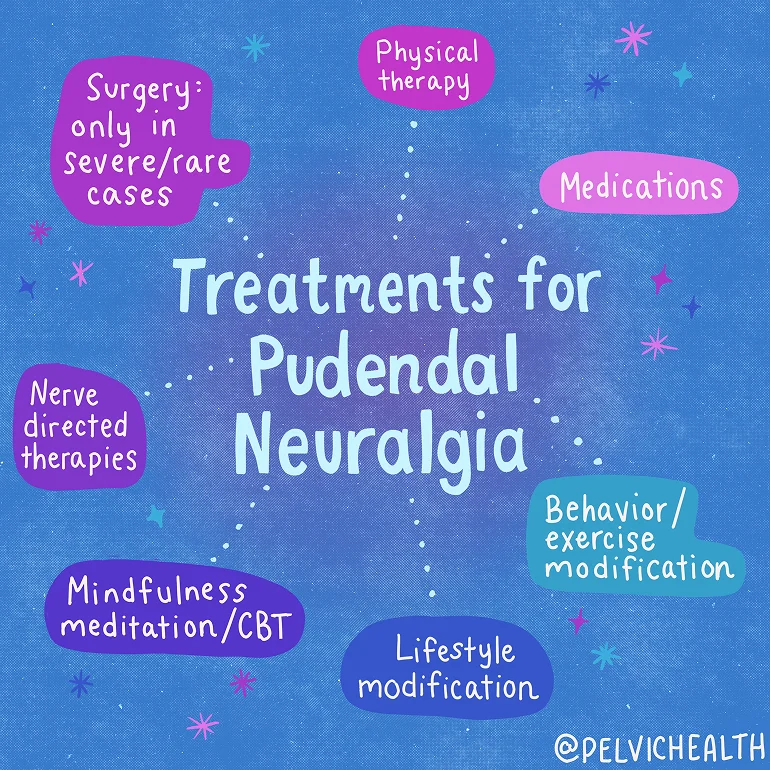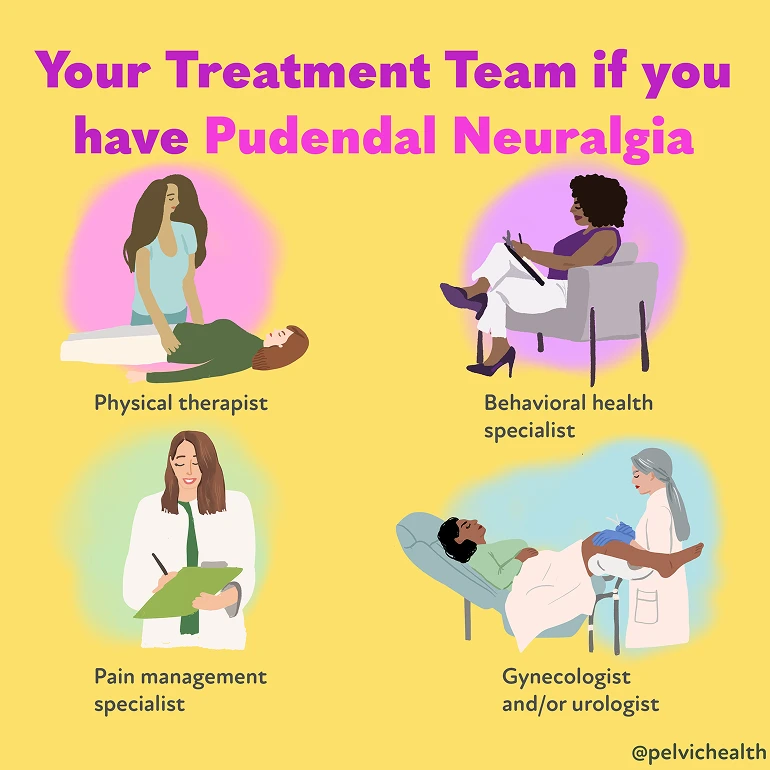Table of Contents
-
.
-
.
-
.
-
.
-
.
-
.
-
.
-
.
-
.
When Should I See a Pelvic Floor Physical and Occupational Therapists?
-
.
Pudendal neuralgia is an often misunderstood and misdiagnosed source of chronic pain. Additionally, this condition doesn’t just cause pain; it can affect how you sit, move, and live your life.
At the Pelvic Health and Rehabilitation Center (PHRC), we specialize in treating pudendal neuralgia. PHRC cofounders Elizabeth Akincilar and Stephanie Prendergast specialized in this condition in the early 2000’s. They recognized the need for medical professionals to undergo training to diagnose and treat pudendal neuralgia and developed the first continuing education course for medical professionals on this topic in 2007. They taught the course over 40 times around the world and regularly lecture about pudendal neuralgia at medical and physical and occupational therapy conferences.
As pelvic floor physical and occupational therapists, we work closely with individuals who have spent years searching for answers, often seeing multiple providers before receiving an accurate diagnosis. There is simply a shortage of medical doctors and pelvic floor physical and occupational therapists qualified to treat this diagnosis. Through a combination of expertise, evidence-based care, interdisciplinary management with trusted colleagues, and a deep understanding of the pelvic nervous and musculoskeletal system, we help clients find relief, regain function, and feel like themselves again.
What is Pudendal Neuralgia?
Pudendal neuralgia is a common condition that causes pelvic pain. When this nerve becomes inflamed or entrapped, it can lead to burning, stabbing, or aching pain in the pelvic region, often worsened by sitting. It can lead to issues with urination, bowel movements, and sexual function.
The term ‘neuralgia’ means neuropathic pain in the distribution of a nerve. The pudendal nerve originates from sacral nerve roots two, three, and four and takes a complex route through the pelvis. This route includes the pelvic floor muscles, sacrotuberous and sacrospinous ligaments, and Alcock’s Canal. Along its path, the nerve splits into branches, making sharp angles and turns, which increases its risk of injury/compromise.
The pudendal nerve’s sensory coverage includes the vulva (clitoris, labia major/minora, vestibule), the penis and scrotum, the last third of the urethra and rectum, the anal and urinary sphincters, the perineum, and pelvic floor muscles. It is a very unique mixed nerve (it contains sensory, motor, and autonomic fibers). These components allow it to provide feeling, muscle movement, and voluntary and involuntary control of urinary, bowel, sexual function, and muscle activation.
Although pudendal neuralgia is considered rare, with some sources estimating it affects about 1 in 100,000 people, that number might not reflect the true prevalence. Many individuals go undiagnosed or misdiagnosed for years, often because few healthcare providers are familiar with the condition or how to properly assess the pudendal nerve.
At PHRC, we regularly see clients who have spent months or even years seeking answers for their pain. Pudendal neuralgia doesn’t appear clearly on imaging or standard tests, which makes a detailed clinical evaluation essential. That’s where pelvic floor physical and occupational therapists come in. Pelvic floor physical and occupational therapy is a key component of recovery, offering strategies to reduce pressure on the nerve, calm the nervous system, and improve mobility and function over time.
What are the Symptoms of Pudendal Neuralgia?
Symptoms of pudendal neuralgia include:
- Burning, shooting, stabbing pain in the genitals, perineum, or anus
- Urinary urgency, frequency, burning before, during, or after urination
- Pain before, during, or after bowel movements
- Pain before, during, or after sexual activity and orgasm
- Symptoms are worse when sitting versus standing or lying down
- Symptoms can be provoked by trunk flexion, hip flexion, external rotation of the hip, and certain exercises/activities such as squats, lunges, walking uphill, and sitting
Multiple nerves innervate the pelvic region, including the following. The symptoms of pudendal neuralgia (including burning, shooting, or stabbing pain) can occur in some or all of the structures the involved nerve supplies sensation to.
- Ilioinguinal Nerve
- Genitofemoral Nerve
- Illiohypogastric Nerve
- Posterior Femoral Cutaneous Nerve
- Sciatic Nerve
- Obturator Nerve
- Pudendal Nerve
What Causes Pudendal Neuralgia?
Symptoms of neuralgia occur when the nerve is compromised in a manner that interrupts its ability to slide, glide, and move normally. Common causes of pelvic neuralgias include:
- Surgical scars from hernia repairs, cesarean section, and laparoscopic abdominal and pelvic surgeries
- External trauma, such as car accidents or falls
- Musculoskeletal and joint dysfunction
- Hernias
The pudendal nerve has a more complicated course than other pelvic nerves, making it more prone to injury. The aponeurosis (a flat, strong layer of connective tissue) of the obturator internus muscles forms a fascial canal (a tunnel made of connective tissue) called Alcock’s Canal, which houses a main branch of the pudendal nerve. Common causes of pudendal neuralgia include:
- Obturator Internus, Piriformis, and/or pelvic floor dysfunction
- Altered lumbo-pelvic-hip mechanics
- Compression issues (sitting, cycling, horseback riding)
- Tension issues (constipation, childbirth, heavy weight lifting involving squats/lunges)
- Surgical insult (pelvic organ prolapse repair, prostatectomy)
How Is Pudendal Neuralgia Diagnosed?
Pudendal neuralgia isn’t well understood by the majority of medical providers, which makes getting an accurate diagnosis difficult for most people. Medical and physical and occupational therapy schools do not include training on pudendal neuralgia. Providers aren’t trained to recognize the condition, let alone feel confident recommending treatment. Because of this, many people end up trying to diagnose themselves, often after reading online that pelvic pain while sitting might mean pudendal neuralgia.
But sitting pain or nerve pain in the vagina or pelvis can come from many different sources, and not all nerve-related pelvic pain involves the pudendal nerve. There are multiple nerves that serve the pelvic region, so it takes a skilled provider to narrow down the true source or sources of pain.
Diagnosing pudendal neuralgia involves a detailed clinical evaluation. There is no single test that confirms the diagnosis. Instead, a diagnosis is made based on your symptoms, a thorough medical history, and a physical exam that assesses your pelvic floor muscles, joint mobility, nerve sensitivity, and movement patterns. Your provider might also rule out other possible causes of pelvic pain through imaging or referrals to specialists.
One main part of the diagnostic process is identifying patterns that match pudendal nerve involvement, such as pain worsened by sitting, burning or stabbing sensations in the pudendal nerve distribution, and relief when sitting on a toilet or cut-out cushion.
Another challenge lies in separating pudendal neuralgia from pudendal nerve entrapment. While the symptoms might overlap, entrapment means the pudendal nerve is physically compressed or stuck somewhere along its path. Right now, there’s no reliable imaging or diagnostic test that can confirm pudendal nerve entrapment. The only way to know for sure is during surgical decompression of the nerve, which isn’t a path most people take without exhausting other options first.
Thankfully, awareness is growing. More providers now recognize the signs of pudendal neuralgia and know when to refer patients to specialists. At PHRC, we help clients understand what’s contributing to their pain and guide them toward a diagnosis that actually fits their experience.
What are the Associated Diagnoses?
Pudendal neuralgia often overlaps with or is mistaken for other pelvic conditions. These associated diagnoses can either contribute to pudendal nerve irritation or exist alongside it, making the pain more complex. Below are some of the most common:
Myofascial Pelvic Pain Syndrome
This condition involves chronic tightness and trigger points in the pelvic floor muscles. When the muscles stay in a guarded or overactive state, they can compress nearby nerves—including the pudendal nerve—leading to nerve-like symptoms even when the issue is muscular.
CPPS (Chronic Pelvic Pain Syndrome or Male Pelvic Pain Syndrome)
CPPS is a broad diagnosis used when men experience persistent pelvic pain without a clear infection or medical cause. Symptoms might include testicular pain, perineal discomfort, and urinary or sexual issues. In many cases, the pudendal nerve plays a role, but the pain can also stem from other nerves or musculoskeletal dysfunction.
Endometriosis
Endometriosis occurs when tissue similar to the uterine lining grows outside the uterus, often affecting pelvic structures. It can lead to widespread inflammation, adhesions, and nerve irritation. In some individuals, endometriosis contributes to pelvic nerve pain or creates a sensitized environment that makes pudendal neuralgia more likely.
Vestibulodynia
Vestibulodynia is characterized by pain at the vaginal opening (vestibule), often described as burning, rawness, or irritation. While it can have hormonal or inflammatory roots, it’s sometimes related to nerve hypersensitivity or pelvic floor muscle dysfunction that overlaps with pudendal neuralgia.
Pudendal Nerve Entrapment
This is a specific condition where the pudendal nerve becomes compressed or mechanically stuck along its path through the pelvis. While all entrapments involve pudendal neuralgia, not all cases of pudendal neuralgia are due to entrapment. Diagnosing entrapment remains difficult without surgical confirmation.
“Cyclist’s Syndrome”
This is also known as pudendal neuralgia, caused by prolonged pressure on the perineum, this condition often affects cyclists due to long hours on a bike seat. The constant compression can irritate or damage the pudendal nerve, resulting in pain or numbness in the pelvic area.
What Role Does Pelvic Floor Dysfunction Play in Pudendal Neuralgia?
The pelvic floor is a group of muscles across the bottom of the pelvis, supporting your bladder, bowel, and reproductive organs. These muscles also help with posture, core stability, and bowel and bladder control. Just like any other muscle group, they can become tight, weak, or uncoordinated—and when that happens, they can contribute to pain and dysfunction.
Pelvic floor dysfunction is often a leading cause of pudendal neuralgia. When these muscles stay in a chronically tight or overactive state, they can place pressure on the pudendal nerve or nearby structures. Over time, this ongoing tension can irritate the nerve, leading to burning, stabbing, or aching sensations along its path.
The pudendal nerve travels through very narrow spaces between muscles, ligaments, and fascia. If those tissues are restricted or inflamed, they can trap or compress the nerve. In some cases, the body reacts to this pain by guarding or clenching the pelvic floor even more, creating a cycle that’s hard to break without targeted intervention.
That’s why treating the muscular and structural imbalances of the pelvic floor is such an important part of finding relief from pudendal neuralgia.
What is the Treatment for Pudendal and Pelvic Neuralgias?
Most cases of pelvic and pudendal neuralgias have a neuro-muscular pelvic floor and girdle component. Therefore, pelvic floor physical or occupational therapy should always be offered as a first-line treatment for these syndromes. Because these syndromes affect urinary, bowel, and sexual dysfunction as well as daily comfort and ability to perform professional and recreational activities, interdisciplinary care that includes the following treatments can be the most effective:
- Pelvic floor physical therapy or occupational therapy
- Pharmacologic management with a pain management doctor
- Procedural interventions (nerve blocks, Botox injections to surrounding dysfunctional muscles, regenerative injections such as PRP or stem cells, dry needling)
- Pain Science education and stress management strategies
- Temporary lifestyle modifications
- Surgical intervention in cases of suspected entrapment
How Pelvic Floor Physical and Occupational Therapy Helps
Pelvic floor physical and occupational therapy targets the underlying causes of pudendal nerve irritation by treating the muscles, joints, nerves, and soft tissue of the pelvic region. At PHRC, we use a variety of techniques to calm the nervous system, release muscle tension, and improve mobility.
Treatment includes:
- Assessing the pelvic floor muscles for overactivity, weakness, or restriction
- Using manual therapy to release tight muscles, fascia, and scar tissue
- Retraining the pelvic floor and core muscles to improve coordination and reduce strain
- Incorporating breathwork and relaxation techniques to calm the nervous system and reduce pain
- Addressing posture, walking mechanics, and movement patterns that may contribute to ongoing tension
- Coordinating care with other providers (such as pain management specialists, gynecologists, or surgeons) as part of a comprehensive approach
Pelvic floor PT is often part of a larger care plan. For many people with pudendal neuralgia, it’s one of the most effective ways to reduce pain, improve function, and return to a more comfortable life.
What To Expect During a Physical and Occupational Therapy Session
If you’re dealing with pelvic pain from pudendal neuralgia, starting with a physical and occupational therapist who specializes in pelvic pain can be an important step toward relief.
At your first visit, we take time to understand your full story. We’ll go over your symptoms, past diagnoses, previous treatments, and how those treatments have worked—or haven’t. Many people come to us feeling frustrated after seeing multiple providers, and we recognize just how challenging that journey can be.
During the physical exam, we assess your muscles, joints, connective tissue, nerves, and how your body moves. This hands-on evaluation helps us figure out what’s contributing to your pain.
After the assessment, we walk you through what we found and explain how these patterns might be related to pudendal neuralgia.
From there, we create a plan with both short-term and long-term goals based on your needs. Most people benefit from coming to physical and occupational therapy one to two times per week for about 12 weeks. You’ll also receive a home exercise program designed to support your progress between visits.
Throughout your care, we collaborate with your broader treatment team (including medical doctors and other specialists) to keep everyone on the same page. Our goal is to help you reduce pain, move with more ease, and get back to living your life more comfortably.
Tips for Living with Pudendal Neuralgia
Managing pudendal neuralgia often requires a mix of treatment and day-to-day strategies. While physical and occupational therapy plays a big role, small adjustments to your routine can also make a difference in how you feel. Here are some practical tips we often share with clients:
- Use a cut-out cushion when sitting to reduce pressure on the pudendal nerve
- Take standing breaks or walking breaks regularly if your job or lifestyle involves long periods of sitting
- Avoid activities that increase symptoms, such as deep squats, heavy lifting, or cycling
- Focus on gentle movement like walking, stretching, or low-impact exercise to keep circulation flowing
- Practice deep breathing and relaxation techniques to help downtrain the nervous system and reduce muscle tension
- Stay consistent with your home exercise program as guided by your pelvic floor physical and occupational therapist
- Track your symptoms to notice patterns or triggers you can adjust
- Be patient with your progress since healing from pudendal neuralgia often happens gradually
- Seek emotional support through therapy, support groups, or trusted friends, especially if the pain has impacted your quality of life
You’re not alone in this. With the right care, self-awareness, and ongoing support, it is possible to manage symptoms and reclaim your comfort.
Get Help Today at PHRC
Living with pudendal neuralgia can be exhausting, especially when answers feel hard to come by. At PHRC, we’re here to listen, assess, and guide you toward meaningful relief. We take a whole-body approach to care, focusing not just on your symptoms but on the underlying patterns that contribute to them.
Our team of pelvic floor physical and occupational therapists brings both clinical expertise and genuine compassion to every session. We work with you to build a plan that fits your life and helps you move forward.
If getting to the clinic is a challenge, we offer telehealth appointments following your first in-person visit, so you can keep making progress no matter where you are.

